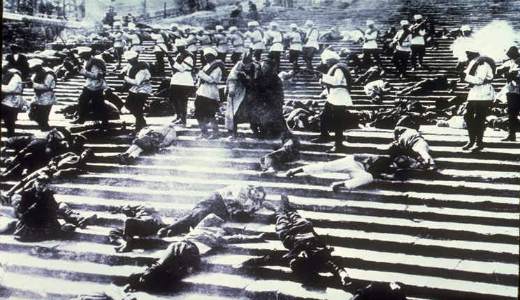
Movie Review
Potemkin
Directed by Sergei Eisenstein
1925, 75 mins., Not Rated
In my view, the best movie ever made was before the cinema had sound or color (except for that hand-tinted red flag!). Nor are there movie stars or a sexy love story in Sergei Eisenstein’s 1925 Potemkin, based on the real-life saga of a revolt aboard a ship that spread like wildfire to the Ukrainian port city of Odessa.
But there is a kind of romance in this Soviet classic (also called Battleship Potemkin), of which a newly remastered version is being theatrically re-released.
When I was a student I read Rosa Luxemburg’s stirring 1906 pamphlet The Mass Strike, and never forgot one indelible line: “But in the storm of the revolutionary period even the proletarian is transformed from a provident paterfamilias demanding support, into a ‘revolutionary romanticist,’ for whom even the highest good, life itself, to say nothing of material well-being, possesses but little in comparison with the ideals of the struggle.”
Yes, in the excitement of revolution, people are lifted out of their petty mindsets and ruts, and all things suddenly seem possible. Unlike general strikes, which are generally planned and called for by trade unions, mass strikes usually originate spontaneously and, in fertile soil, mushroom and go viral. Most recently, a Tunisian fruit vendor set himself on fire in order to protest the state’s abuses, setting off the uprisings now rocking North Africa and the Middle East – and arguably Wisconsin.
In Potemkin, as the title cards reveal (all 146 have been restored), as upheaval sweeps 1905 czarist Russia, sailors refuse to eat maggoty meat, touching off a mutiny, and then a strike by Odessa’s working class. A literal cast of thousands pours across the screen in support of their mutinous mates. This movie’s “stars,” of course, are the aroused workers and sailors, finally asserting their rights and breaking the chains of oppression in order to win a new liberated world. Supremely notable is the mass psychology of the people in the act of defiant solidarity and rebellion: They are nearly ecstatic. We saw this elation among the crowds in Cairo’s Tahrir Square as they threw off their tyrants.
Of course, the czarist thugs must put the workers back into their place and stamp out this outpouring of mass joy and unity, so they sic their Cossack dogs on the unarmed civilians in what is arguably the silver screen’s most terrifying scene of mass violence. The Odessa Steps sequence is a dramatic tour-de-force of montage, with rapid editing that pops your eyes and tugs your heartstrings. These five minutes will have you on the edge of your seat.
The carnage, however, never happened as portrayed onscreen. According to legend, while planning Potemkin Eisenstein stood atop the Odessa Steps taking in the waterfront vista and chewing cherries. Spitting the pits out, he noticed them bounce down the stairs, and an idea was born. This unforgettable spectacle of slaughter, brilliantly shot by Eduard Tisse, only “lies” in order to tell a larger truth about brutal czarist repression.
The sailors aboard the Potemkin boldly respond to the mass killing, but the czarists deploy a squadron to defeat the mutiny. Undaunted, the Potemkin courageously steams toward the entire battle fleet…. What happens next is not only one of the greatest moments in the history of revolutions (yes, it actually happened!), but in film history, and we won’t spoil it for you.
Russian revolutionary leader Vladimir Lenin declared: “For us, the cinema is the most important of the arts.” Alas, he didn’t live long enough to see Eisenstein’s Potemkin. With its jubilant, triumphant vision of human solidarity, it arguably did more to spread the gospel of revolution than any book or pamphlet ever did.
Warning! From its opening, symbolic shots of pounding waves, to the final shot of the approaching battleship, Potemkin retains its revolutionary wallop. This painstakingly restored 35mm version, which features Edmund Meisel’s stirring symphonic score from 1926, may inspire you to stage a strike and stand up to the next capitalist oppressor who tries to cross you. For about 70 minutes you’ll be transformed into an idealistic if armchair revolutionary romantic – talk about getting your money’s worth!
Below is the schedule for the upcoming national re-release of this cinematic masterpiece: The revolution is coming soon – and to a theater near you!
Arizona Loft Cinema: Tucson, August 28 & 30
California Landmark Nuart Theatre: Los Angeles, March 18-24
Connecticut Cinestudio: Hartford, April 10-12
Michigan Detroit Film Theatre: Detroit, March 26, Michigan Theater: Ann Arbor, August 7 & 9
Missouri Tivoli Cinemas: Kansas City, April 8-14
New York Cinema Arts Centre: Huntington, March 29, Proctors Theatre: Schenectady, September 25-26
Pennsylvania County Theater: Doylestown, May 2, Ambler Theater: Ambler, May 4
Washington Northwest Film Forum: Seattle, May 20-26
Don’t miss the best movie ever made! The revolution is coming soon, to a theatre near you!
See excerpts here.










